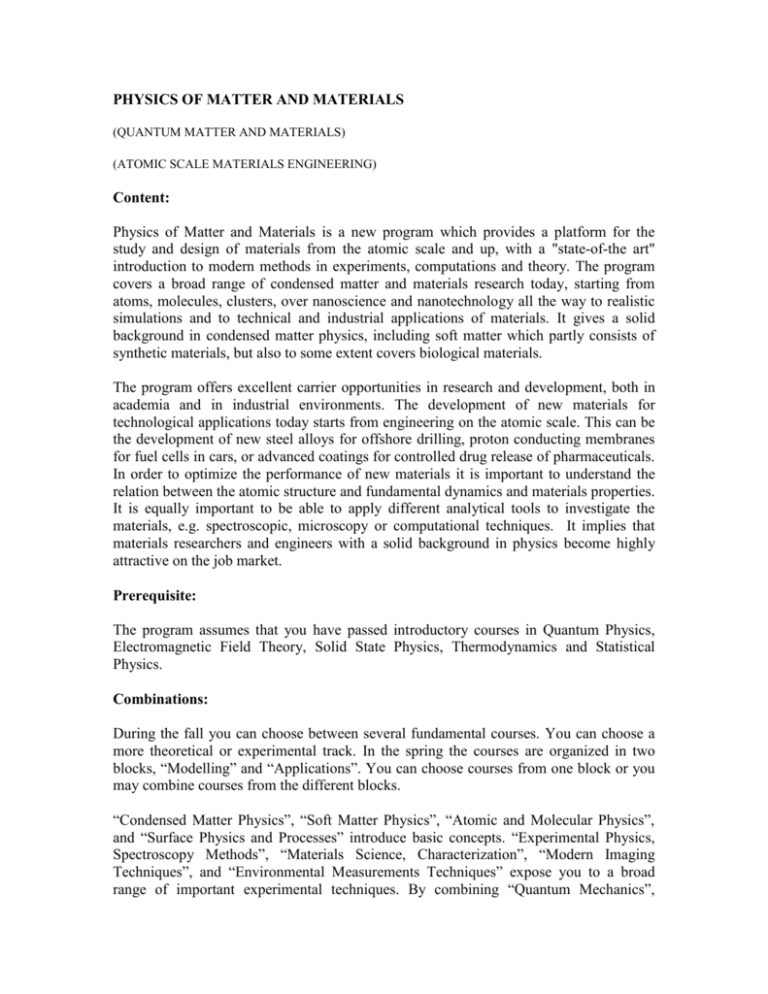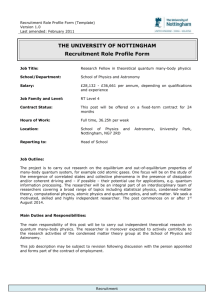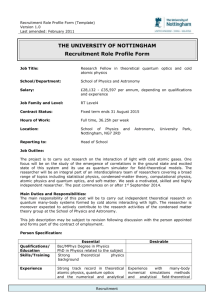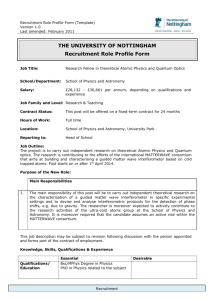Computational Science and Engineering Imre PazsitThu, 9:51
advertisement

PHYSICS OF MATTER AND MATERIALS (QUANTUM MATTER AND MATERIALS) (ATOMIC SCALE MATERIALS ENGINEERING) Content: Physics of Matter and Materials is a new program which provides a platform for the study and design of materials from the atomic scale and up, with a "state-of-the art" introduction to modern methods in experiments, computations and theory. The program covers a broad range of condensed matter and materials research today, starting from atoms, molecules, clusters, over nanoscience and nanotechnology all the way to realistic simulations and to technical and industrial applications of materials. It gives a solid background in condensed matter physics, including soft matter which partly consists of synthetic materials, but also to some extent covers biological materials. The program offers excellent carrier opportunities in research and development, both in academia and in industrial environments. The development of new materials for technological applications today starts from engineering on the atomic scale. This can be the development of new steel alloys for offshore drilling, proton conducting membranes for fuel cells in cars, or advanced coatings for controlled drug release of pharmaceuticals. In order to optimize the performance of new materials it is important to understand the relation between the atomic structure and fundamental dynamics and materials properties. It is equally important to be able to apply different analytical tools to investigate the materials, e.g. spectroscopic, microscopy or computational techniques. It implies that materials researchers and engineers with a solid background in physics become highly attractive on the job market. Prerequisite: The program assumes that you have passed introductory courses in Quantum Physics, Electromagnetic Field Theory, Solid State Physics, Thermodynamics and Statistical Physics. Combinations: During the fall you can choose between several fundamental courses. You can choose a more theoretical or experimental track. In the spring the courses are organized in two blocks, “Modelling” and “Applications”. You can choose courses from one block or you may combine courses from the different blocks. “Condensed Matter Physics”, “Soft Matter Physics”, “Atomic and Molecular Physics”, and “Surface Physics and Processes” introduce basic concepts. “Experimental Physics, Spectroscopy Methods”, “Materials Science, Characterization”, “Modern Imaging Techniques”, and “Environmental Measurements Techniques” expose you to a broad range of important experimental techniques. By combining “Quantum Mechanics”, “Statistical Physics”, and “Quantum Matter, Correlation and Coherence” you get a solid theoretical basis. “Computational Physics” and “Computational Materials Physics” present powerful computational techniques. Various applications can be found in “Cluster, Fullerenes, and Nanotubes”, “Materials Science of Biomaterials” and in “Deformation Mechanisms”. Thesis work: A large number of research groups offer topics for thesis works. We also collaborate with several companies, e.g. ABB, AstraZeneca, Ericsson, ESAB, Nobelpharma, Saab, Sandvik Coromant, Sandvik Steel, Seco Tools, SCA, SKF, and Volvo, and together with these industrial partners you can also do your thesis work. Courses: Fall: period 1: choose two of - Experimental Physics, Spectroscopy Methods - Soft Matter Physics - Quantum Mechanics period 2: - Condensed Matter Physics and choose one of - Atomic and Molecular Physics - Materials Science, Characterization - Surface Physics and Processes Spring: "Modeling" period 3 - Computational Physics - Statistical Physics period 4 - Computational Materials Physics - Quantum Matter, Coherence and Correlation "Applications" period 3 - Modern Imaging Methods - Cluster, Fullerenes, and Nanotubes - Materials Science of Biomaterials period 4 - Deformation Mechanisms - Environmental Measurement Techniques






